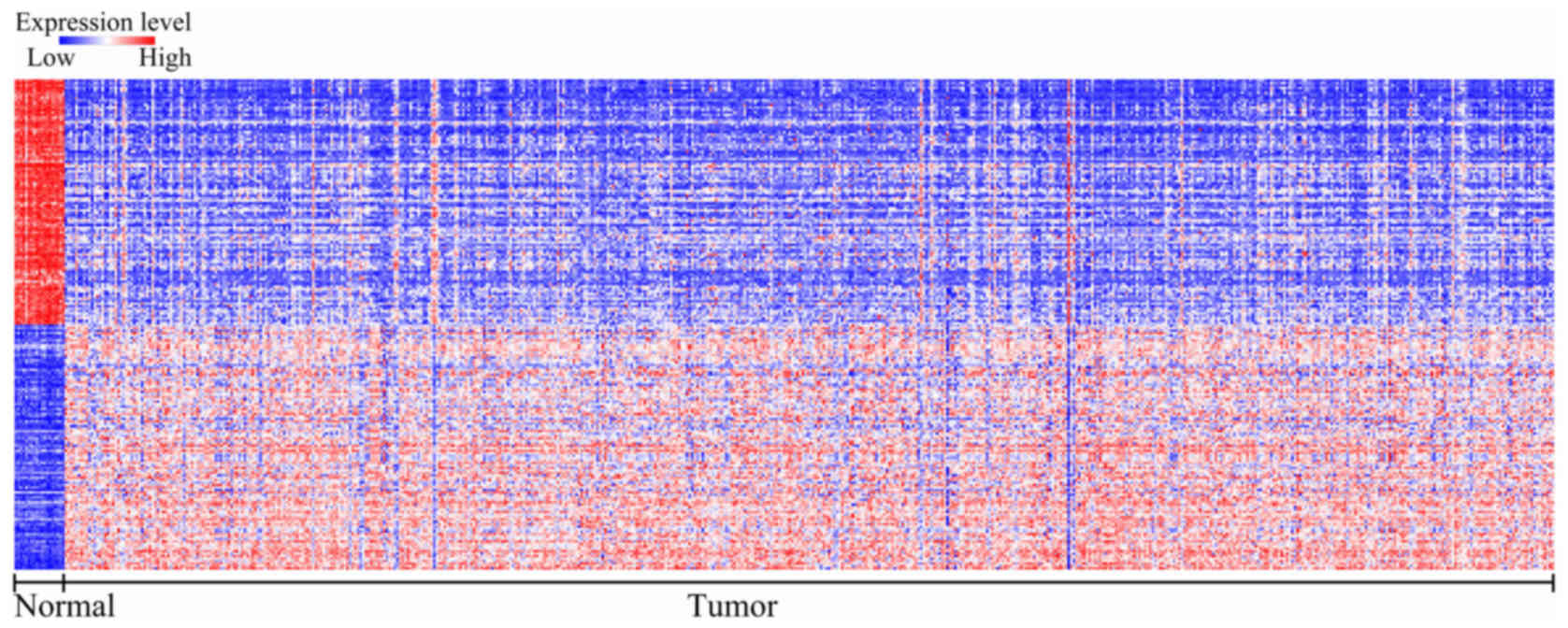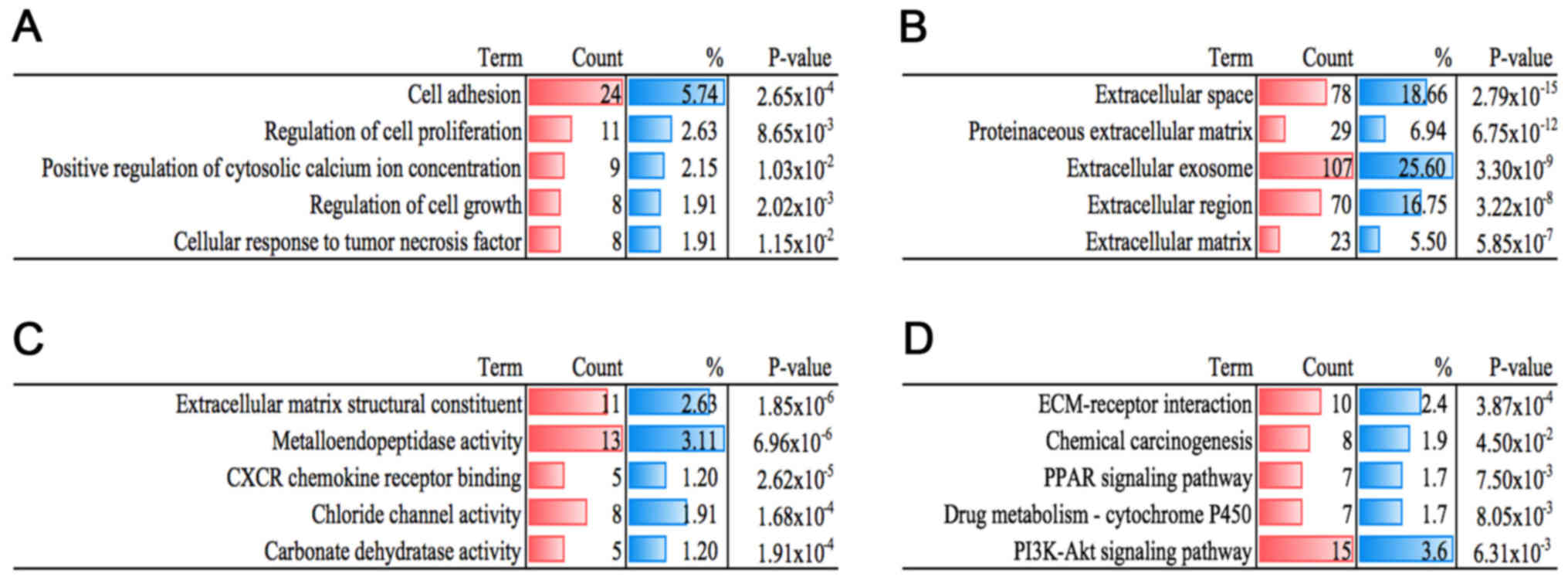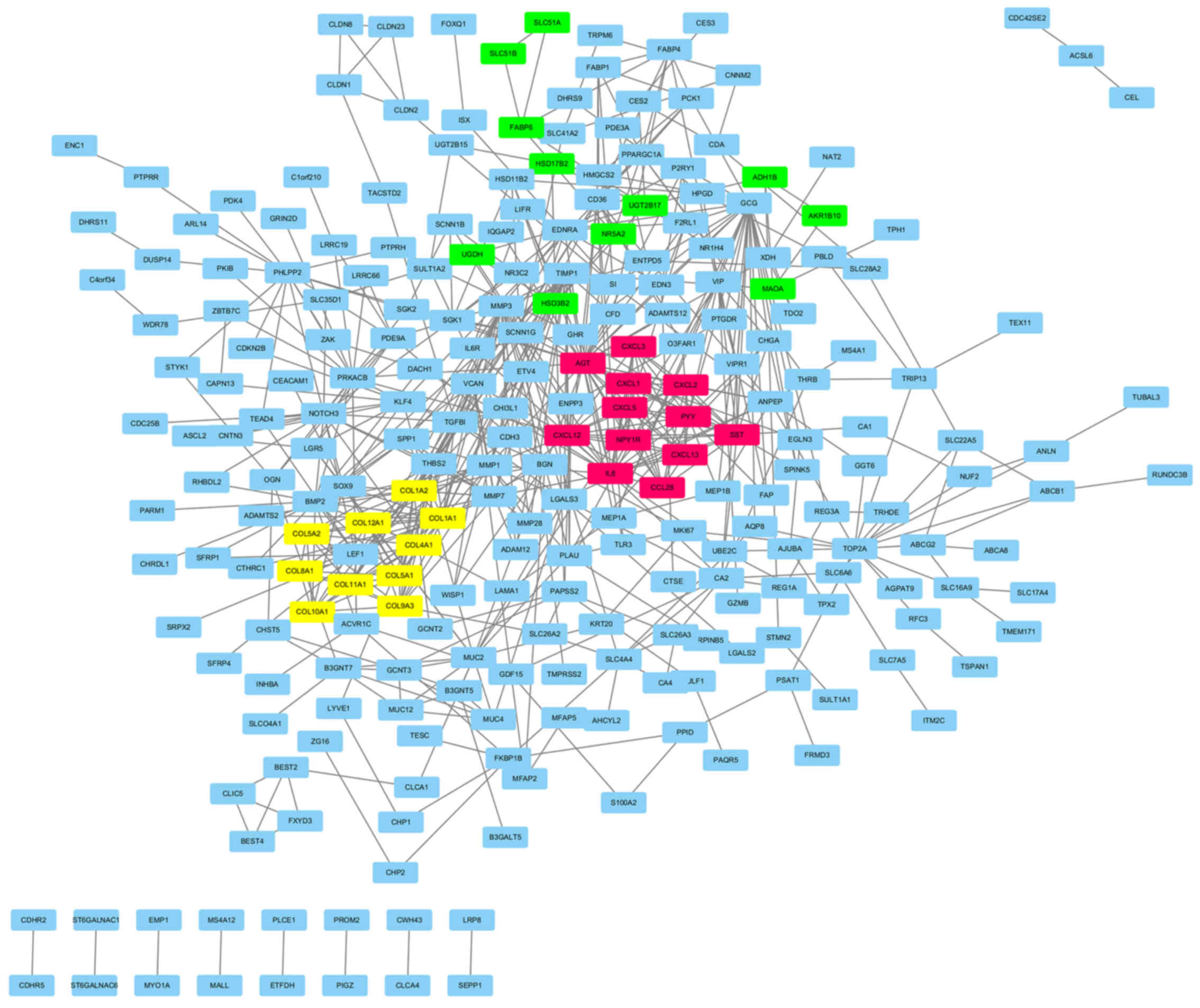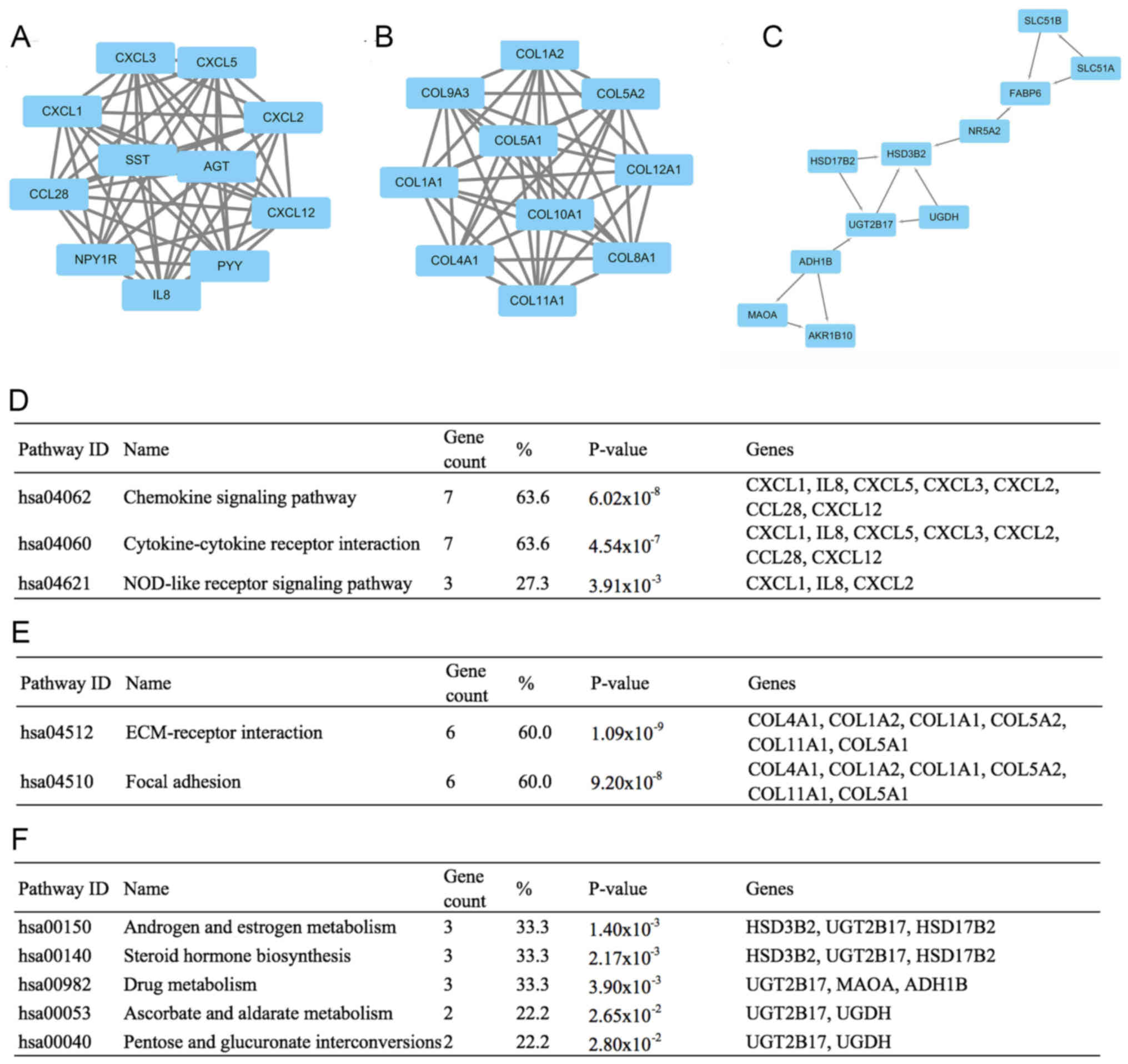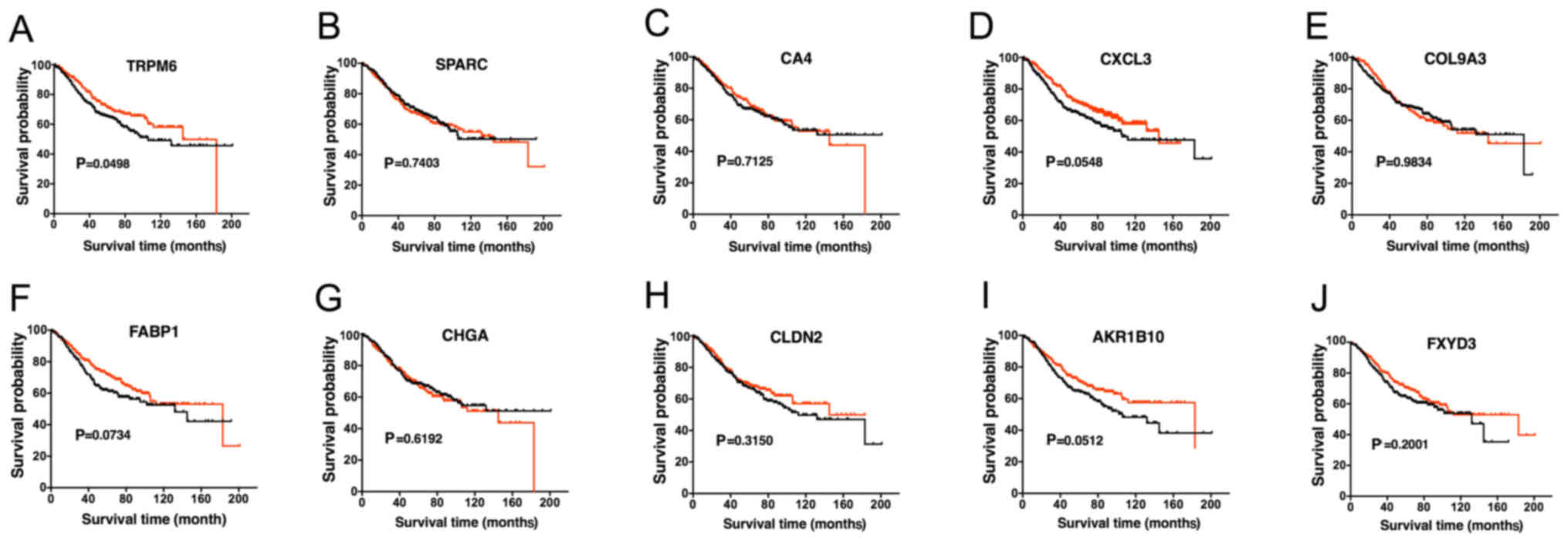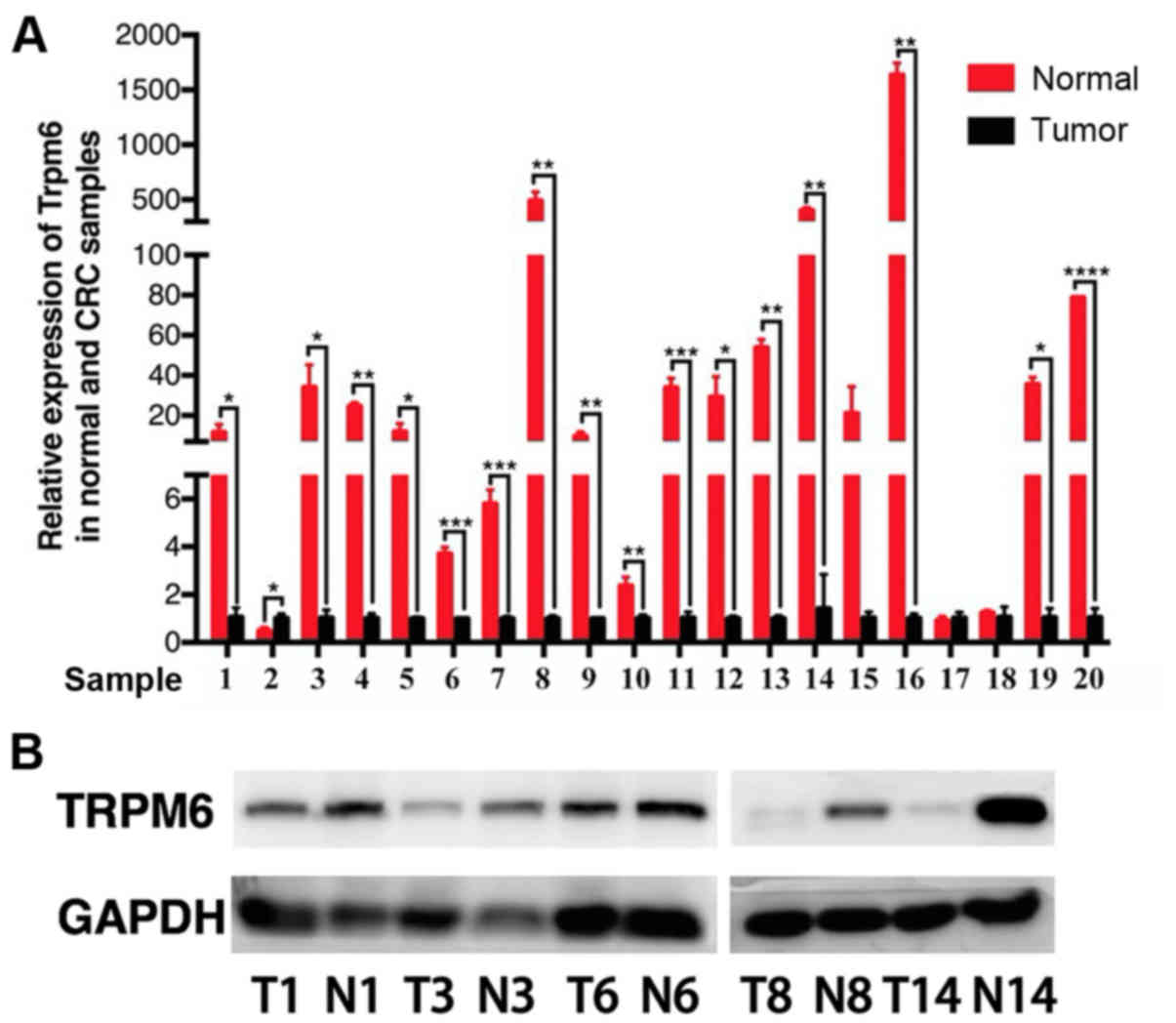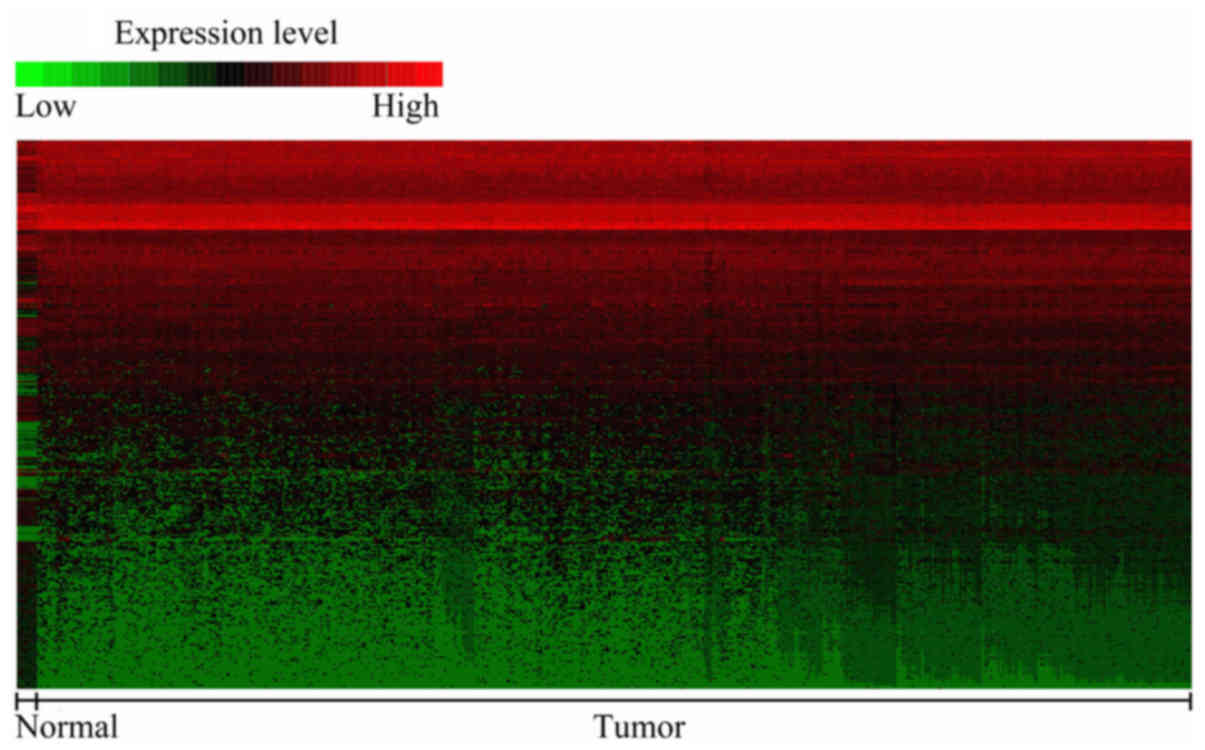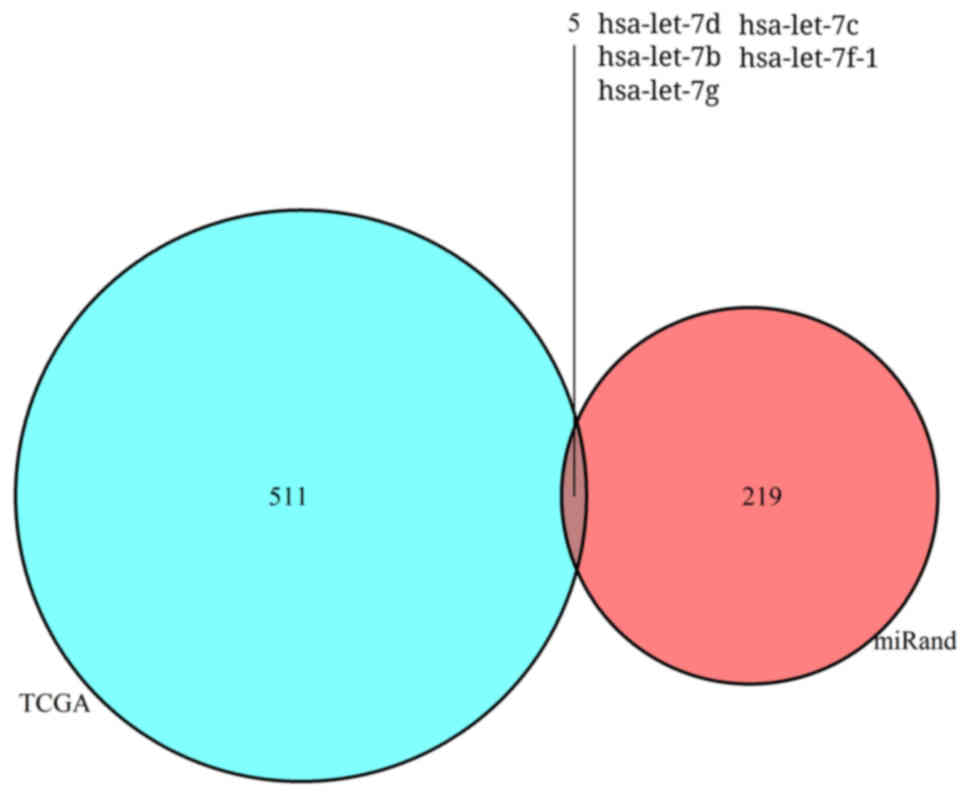Identification of key tumorigenesis‑related genes and their microRNAs in colon cancer
- Authors:
- Published online on: September 21, 2018 https://doi.org/10.3892/or.2018.6726
- Pages: 3551-3560
Abstract
Introduction
Colorectal cancer (CRC) is one of the most commonly diagnosed malignant tumors and the primary cause of cancer-related deaths worldwide. In 2017, >135,000 individuals with newly diagnosed CRC and over 50,000 deaths from the disease were reported in the United States. In spite of 58% new cases of patients over 65 year of age, the number of patients under the age of 65 diagnosed with CRC is exponentially increasing (1,2). CRC is caused by many factors, such as genetics, lifestyle and environment (3). In addition, there is solid evidence that tumorigenesis of CRC is a multi-gene and multi-pathway driven process (4–6). More than 70% of colorectal adenoma occur in the APC gene mutation site at an early stage and further promotes adenocarcinoma by activating mutations of the KRAS gene and inactivating TP53 gene. The mutations in these representative genes are often accompanied by changes in the number and structure of chromosomes. More than 15% of sporadic CRCs occur by other ways, including the CpG island methylator phenotype, activation of BRAF oncogene mutations and MLH1 gene promoter methylation (7). Several signaling pathways such as Wnt-associated signaling pathway, Hippo pathway and PI3K pathway have been associated with CRC (8–10). Many reports have indicated the abnormal expression of certain miRNAs, which also induce CRC cell proliferation and migration (11). To date, the fundamental pathophysiology of the disease has not been fully elucidated, and remains a major obstacle for clinical diagnosis and treatment.
In the last decade, microarray technology has been broadly used to filter out CRC-specific differentially expressed genes (DEGs). Iwaya et al identified DEGs between CRC patients and normal colon epithelium (12). Yan et al also identified potential biomarkers for the prognosis and prevention of CRC (13). Bioinformatic methods owing to their efficiency in dealing with high-throughput data are currently now in use, but the most representative DEGs or pathways still need to be identified. In addition, bioinformatic study combining mRNA and miRNAs to investigate the pathophysiological mechanisms of CRC has seldom been put forward. Thus, our research aimed to associate mRNA with microRNAs (miRNAs) to promote the discovery of potential diagnostic and therapeutic targets.
In the present study, we utilized the expression profiling data submitted by Marisa et al (14) to identify the DEGs between colon cancer samples and normal mucosa in Gene Expression Omnibus (GEO) 2R (https://www.ncbi.nlm.nih.gov/geo/geo2r/). Combining with the data of The Cancer Genome Atlas (TCGA) (https://portal.gdc.cancer.gov/), Oncomine (https://www.oncomine.org/), the tools of Database for Annotation, Visualization and Integrated Discovery (DAVID), Search Tool for the Retrieval of Interacting Genes (STRING) (https://string-db.org/), Cytoscape (http://www.cytoscape.org/), quantitative polymerase chain reaction (qPCR) and western blotting, the hub genes and its regulatory microRNAs (miRNAs) were screened and explored further.
Materials and methods
Identification of DEGs
Gene expression profiling of GSE39582 (14), a dataset based on Agilent GPL570 platform (Affymetrix Human Genome U133 Plus 2.0 Array), was downloaded from the GEO (https://www.ncbi.nlm.nih.gov/geo/) database. It contained 585 samples, and was divided into 2 groups: the tumor group consisted of 566 colon cancers, while the normal group consisted of 19 non-tumoral colorectal mucosa in GEO2R, an R-based web application (15). The genes that met the conditions of log2 fold change (logFC) of ≥2 and P-value <0.05 were considered as DEGs. Then we applied hierarchical clustering analysis to classify the data in Morpheus (https://software.broadinstitute.org/morpheus/).
Enrichment analysis of DEGs
Gene Ontology (GO) database (http://www.geneontology.org/) described the facilities of genes and their products from three distinct biologic aspects: Biological process (BP), cellular component (CC) and molecular function (MF) (16). Kyoto Encyclopedia of Genes and Genomes pathway (KEGG) (http://www.kegg.jp), a comprehensive knowledge database, plays an important role in both functional interpretation and practical application of genomic information (17). The DEG list was uploaded to DAVID (v 6.8) to obtain enriched GO terms and significant pathway analysis with P<0.05.
Assessment of PPI network
STRING database is an online database of known and predicted protein-protein interactions (PPIs). STRING (version 10.0) includes 9,643,763 proteins from 2,031 living organisms. To assess the interactions among DEGs, we mapped them to STRING database and the coactions with a combined score of >0.4 were considered. Then, the PPI networks were visualized using Cytoscape software and the modules of DEGs were established by the Molecular Complex Detection (MCODE) with the concrete selection standards, which were as follows: MCODE scores >2 and number of nodes >9. In addition, hub genes were exported. Moreover, the KEGG pathway enrichment analysis was performed for genes within these modules separately.
Analysis of expression level of hub gene in TCGA and Oncomine
To obtain a picture of the hub genes' quality for further research, we compared the corresponding expression information using TCGA and Oncomine database. The gene expression quantification data of colorectal adenocarcinoma were downloaded from the TCGA database and it consisted of 521 individual data files, metadata and cart. Then, we obtained the list of DEGs between 480 colorectal adenocarcinoma and 41 normal samples using edgeR package (http://www.bioconductor.org/packages/release/bioc/html/edgeR.html) in R software with the following criteria: logFC ≥1 and P<0.05. Moreover, we searched the expression profile of the hub genes in Oncomine database, respectively with the following conditions: Gene, Cancer vs. Normal Analysis and Colorectal cancer type.
Survival analysis of hub genes
On the basis of the survival prognosis information of colon cancer patients in GSE39582, we calculated the survival curves of hub genes using GraphPad Prism version 6.0 (GraphPad Software, Inc., La Jolla, CA, USA) and P<0.05 was thought to be significant.
Patients and tissue samples
In terms of the conditions, where high expression of TRPM6 was linked with a better overall survival (OS), 20 non-selected CRC samples were applied to perform qPCR to validate the expression difference of TRPM6 in colon cancer and normal colon mucosa (10 cm away from visible tumor edges). These experimental samples were collected at the Sir Run Run Shaw Hospital of Zhejiang University between January 2004 and December 2006. There were 16 males and 4 females (average age, 66.4 years; range, 49–88 years). The pathological stage was defined according to UICC/AJCC and TNM classification system (https://www.uicc.org/resources/tnm). The details are shown in Table I. Each experimental sample was divided into two parts, one was used for histopathological evaluation and one for total RNA extraction. Research was authorized by the Ethics Committee of Sir Run Run Shaw Hospital and informed consent was obtained from all participating patients. The reference number was 20180226-88.
qPCR validation of TRPM6
The RNA of tissue samples was extracted using Trizol reagent (Invitrogen; Thermo Fisher Scientific, Inc., Waltham, MA, USA) following the manufacturer's instructions. RNA was quantified by applying a NanoDrop 2000c spectrophotometer (Thermo Fisher Scientific, Inc., Waltham, MA, USA). cDNA was synthesized using an RNeasy Mini Kit (Takara, Kyoto, Japan). qPCR analysis was performed with SYBR Green Master Mix (Takara). qPCR was performed at 95°C for 5 min, 45 cycles of 95°C for 5 sec and 60°C for 30 sec; 1 cycle of 95°C for 5 sec, 60°C for 1 min and 95°C for 15 sec and finally, 50°C for 30 sec. Relative expression was analyzed using the 2−ΔΔCq method (18). Expression of mRNA was normalized according to β-actin. The primers used were as follows: β-actin_forward, ACTCTT CCAGCCTTCCTTCC and β-actin_reverse, CGTCATACTC CTGCTTGCTG; TRPM6_forward, TCCTGTCTGAT GATGGGACC and TRPM6_reverse, TCTTGAGCGGCAG TGTATTTTC. We designed the primers on online tools (https://www.genscript.com/tools/real-time-pcr-tagman-primer-design-tool) and these were synthesized by Shanghai Generay Biotech Co. Ltd. (Shanghai, China). We validated the specificity of primers with colon tissue by PCR and then running agarose gel (data not shown).
Western blotting of TRPM6
Tissue samples were directly extracted with radioimmunoprecipitation assay (RIPA) lysis buffer combined with protease inhibitor cocktail to quantify protein expression levels of TRPM6 and GAPDH. The extracted proteins were prepared and resolved by 10% SDS-PAGE and then transferred onto PVDF membranes (Millipore, Billerica, MA, USA). Membranes were blocked by using 5% dry milk dissolved in TBST. The membranes were then incubated overnight at 4°C with antibodies against TRPM6 (BBI Life Sciences Corp., Shanghai, China; 1:1,000 dilution; cat. no. D162419) and GAPDH (Cell Signaling Technology, Inc., Danvers, MA, USA; 1:1,000 dilution; cat. no. 5174). After washing in Tris-buffered saline with Tween (TBST), the membranes were incubated for 2 h in HRP-conjugated secondary antibodies (BBI Life Sciences Corp.; 1:1,0000 dilution; cat. no. D110058-0100,) at room temperature. Excess secondary antibodies (BBI Life Sciences Corp.; 1:1,0000 dilution; cat. no. D110058-0100) were washed and rinsed off from the membranes with TBST. Signals were visualized with an enhanced chemiluminescence kit (Biological Industries, Kibbutz Beth HaEmek, Israel). GAPDH was used as a loading control.
Identification of differentially expressed miRNAs (DEMs)
Similar to the extraction of DEGs from TCGA database, the miRNA expression quantification data of colorectal adenocarcinoma was downloaded and it consisted of 465 individual data files, metadata and cart. Then, we obtained some results of DEMs between 457 colorectal adenocarcinoma and 8 normal samples using edgeR package with the qualification of logFC ≥1 and P-value <0.05.
Prediction of regulatory miRNAs of TRPM6
To locate the regulatory miRNAs of TRPM6 in CRC, we downloaded the files of Human Good mirSVR score, Conserved miRNA and Good mirSVR score, Non-conserved miRNAs from miRanda database (http://www.microrna.org/) to forecast the relationship between TRPM6 and miRNAs. The results of the TCGA-DEMs demonstrated intersection elements via the VennDiagram package (https://cran.r-project.org/web/packages/VennDiagram/index.html) in R software eventually.
Statistical analysis
qPCR results are presented by the use of Graph Pad Prism (version 6.0; GraphPad Software, Inc., La Jolla, CA, USA). Data are presented as the mean ± standard error of the mean. Independent samples t-test was performed for data comparison. P<0.05 was considered to indicate a statistically significant difference.
Results
An overview of the expression levels of the DEGs
To identify the gene signatures during the development of CRC, we compared the expression profiling of the array between colon cancer and non-tumoral mucosae using GEO2R. A total of 439 DEGs were found to play a role in carcinogenesis with P<0.05 and logFC ≥2.0 criteria, and top 50 genes were upregulated and downregulated, which was shown in heat map format performed in Morpheus (https://software.broadinstitute.org/morpheus/) (Fig. 1). These results indicated that colon cancer carcinogenesis is a complex multi-factorial process, which involves several genes.
DEGs are involved in CRC-associated molecular processes
To further investigate the potential mechanisms, we uploaded all the DEGs to DAVID, and then GO functional annotation and KEGG pathway enrichment analyses were conducted separately. As shown in Fig. 2A, many biological processes, such as cellular response to tumor necrosis factor (TNF), regulation of cell proliferation, positive regulation of cytosolic calcium ion concentration, cell adhesion and regulation of cell growth were identified. Additionally, the results of CC and MF are displayed in Fig. 2B and C. As for the KEGG results, DEGs were found to be involved in pathways including chemical carcinogenesis, ECM-receptor interaction, phosphatidylinositol 3-kinase (PI3K)-Akt signaling pathway, chemical carcinogenesis, peroxisome proliferator-activated receptor (PPAR) signaling pathway and drug metabolism-cytochrome P450 (Fig. 2D). These results showed that the DEGs were closely related to cancer and warranted identification.
Key modules and genes were screened out from the PPI network
The PPI network was constructed by the Search Tool for the Retrieval of Interacting Genes (STRING, version 10.0). The network consisted of 624 edges and 401 nodes (Fig. 3). To facilitate our understanding of DEGs, we visualized the network in the Cytoscape software and modularized it using plug-in MCODE. The results showed that these modules were mainly correlated with the chemokine signaling pathway, ECM-receptor interaction and androgen and estrogen metabolism (Fig. 4).
Moreover, the top 10 hub nodes with higher degrees were screened out, which included the upregulated genes that secreted protein acidic and rich in cysteine (SPARC), C-X-C motif chemokine ligand 3 (CXCL3), collagen, type IX, α3 (COL9A3), fatty acid binding protein 1 (FABP1), claudin-2 (CLDN2), and downregulated genes carbonic anhydrase IV (CA4), chromogranin A (CHGA), aldo-keto reductase family 1, member B10 (AKR1B10), transient receptor potential cation channel, subfamily M, member 6 (TRPM6) and FXYD domain containing ion transport regulator 3 (FXYD3) (Table II).
Comparison of expression data of the hub genes
To guarantee that the selected hub genes were credible, we analyzed their expression levels between colon cancer and normal tissues in TCGA and Oncomine. Expression levels of all the genes but FABP1 were consistent in these 3 different databases (Fig. 5 and Table III).
Analysis of the hub genes
Next, we further investigated the prognostic value of these genes. Survival curve was calculated according to the prognostic data of the patients. High expression of TRPM6 demonstrated a higher overall survival (OS) rate (Fig. 6A). In addition, the remaining hub genes were independent of OS (Fig. 6B-K). In this way, we exclusively focused on the abnormality of TRPM6, which was slightly reported previously in CRC. We verified its expression level in clinical specimens by conducting qPCR and western blotting experiments (Fig. 7).
Hub gene TRPM6 may be targeted by hsa-let-7g and hsa-let-7f-1. Owing to the significance of miRNAs in various diseases and their function in suppressing the translation of mRNAs, we analyzed DEMs between colon cancer and normal colon mucosa in TCGA. Compared with normal colon mucosa, 516 DEMs were identified in the colon adenocarcinoma group (Fig. 8). In addition, miRanda database was used to predict the regulatory miRNAs of TRPM6. The results showed that a total of 5 miRNAs were related with TRPM6 through the intersection of the results of TCGA and miRanda (Fig. 9 and Table IV). TRPM6 was downregulated in colon cancer, and hsa-let-7g and hsa-let-7f-1, which were upregulated in colon cancer, were predicted to be the key regulatory miRNAs of TRPM6.
Discussion
In the present study, we explored the vital genes and their miRNAs in the development of CRC, which could enhance our insight of potential molecular mechanisms and benefit diagnosis, treatment and prognosis of the disease. In order to search the tumorigenesis-associated DEGs, we analyzed the gene expression profiling of GSE39582 with GEO2R and further identified 10 hub genes in 439 DEGs by Cytoscape software, which was tested by TCGA and Oncomine database. In terms of the prognostic value of TRPM6, qPCR was conducted in 20 paired colon mucosae samples to validate its role in diagnosis and prognosis of the disease. Moreover, the regulatory miRNAs of TRPM6 were predicted by TCGA and miRanda database. Combined with GO, KEGG and module analysis, our results showed that TRPM6 and other hub genes may play a critical role in the development of CRC. In order to further understand CRC, we innovatively and exclusively focused on the 10 hub genes and two miRNAs, hsa-let-7g and hsa-let-7f-1.
SPARC, CA4, CXCL3, FABP1, CLDN2, AKR1B10 and FXYD3 have previously been reported as genes that are tightly involved in the development of CRC (19–26). COL9A3, CHGA, and TRPM6 have been rarely studied and reported, but which may provide novel insight into the research of CRC. COL9A3 expression was intensely correlated with the expression of SOX10, a sensitive diagnostic marker for both salivary adenoid cystic carcinoma and basal-like breast carcinoma (27). CHGA, a biomarker in neuroendocrine tumors (NETs) (28), was downregulated in colon cancer tissues in this study. The accurate roles of these two genes, COL9A3 and CHGA, remain unclear in CRC.
TRPM6, a gene that belongs to the Transient receptor potential melastatin (TRPM) subfamily, is involved in the physiology of Mg2+ handling, which we exclusively focused on in our study. It was reported that TRPM6 mutations are associated with hypomagnesemia and downregulation of TRPM6 could result in hypomagnesemia (29). Magnesium plays a role in modulating cellular biochemical reactions, such as differentiation, proliferation, apoptosis and migration (30). Many studies have confirmed that hypomagnesemia could promote tumor metastasis (31,32). To date, few reports have discussed the role of TRPM6 in tumors. We found that the upregulation of TRPM6 was associated with prolonged OS in patients, although the survival analysis (P=0.0498) was marginally significant. Considering the limited sample sizes and that only TRPM6 was statistically significant under the same grouping condition, we hypothesized that the level of TRPM6 expression was related to the survival and prognosis of colon cancer patients. Then we tested the mRNA expression level of TRPM6 in patient samples using qPCR. The results revealed that 80% samples showed decreased expression of TRPM6 in colon cancer samples compared with their paired normal tissues. Therefore, we considered TRPM6 as a promising biomarker of tumorigenesis and a treatment target in CRC patients, although the mechanisms of TRPM6 in CRC are still not completely clear. We did not examine expression of all hub genes in the colon cancer samples by qPCR and western blotting and this was a limitation of the study. We assumed that the expression trends of the other hub genes should be in accordance with the results (Tables II and III) based on previous analysis and reports from other investigators (19–26), which need to be experimentally verified in further research.
Hsa-let-7g, a member of the let-7 family playing a vital role in tumorigenesis, was demonstrated to dramatically inhibit the proliferation of hepatocellular carcinoma by downregulating the expression of the oncogene, c-Myc, and upregulating the expression of anti-oncogene, p16(INK4A) (33). Moreover, hsa-let-7g was found to participate in the process of the regulation of autophagy and apoptosis by modulating LOX-1 in vascular smooth muscle cells (34), and an apoptosis-promoting function was also observed in gastric cancer. The relationship between hsa-let-7g and TRPM6 was not validated, but its high-expression trend in colon cancer increased the possibility of the prediction. Similarly, hsa-let-7f-1 is also a member of let-7 family, but research concerning hsa-let-7f-is limited. According to a previous study (35), hsa-let-7f-1 is involved in the Notch signaling pathway, which is closely associated with the development of CRC (36,37). The role of hsa-let-7f-1 and the evidence of the regulatory relationship between hsa-let-7f-1 and TRPM6 should be further elucidated.
In summary, we identified 439 DEGs and 516 DEMs using GEO and the TCGA database between colon cancer and normal colon mucosa. Many of these DEGs, such as SPARC, CA4, CXCL3, FABP1, CLDN2, AKR1B10, FXYD3, COL9A3, CHGA, TRPM6, hsa-let-7g and hsa-let-7f-1, were predicted to be vital molecules related to CRC tumorigenesis. We also analyzed the GSE39582 dataset and found the DEGs of right vs. left colon cancer were not relevant with our hub genes in this study (data not shown). There are also some limitations to our study. For instance, 20 pairs of samples were still not enough and we still have to further verify the expression level of TRPM6 using more samples. We also did not detect the mutations of TRPM6 and confirm the relationship between the mutations and the decreased expression of TRPM6 in colon cancer. In general, our research provides a series of promising targets for diagnosis, treatment and prognosis and provides insight for further investigation into the potential underlying mechanisms.
Acknowledgements
The study represents partial fulfillment of the requirements for a Doctor degree for Dr Binbin Xie.
Funding
The present study was supported by the National Natural Science Foundation of China (grant nos. 81572592, 81772543, 81572361), the Zhejiang Natural Sciences Foundation Grant (LY15H160025, LQ16H160003), the Zhejiang Province Preeminence Youth Fund (LR16H160001), the Zhejiang Medical Innovative Discipline Construction Project-2016, and the Hangzhou Health and Family Planning Commission Fund (2014A61).
Availability of data and materials
The datasets analyzed during the current study are available from the corresponding author on reasonable request.
Authors' contributions
BX, RZ and BB designed the study and drafted the manuscript. BX, YW, YX and SL carried out the experiments. XZ, ZW and YF participated in the statistical analysis of the data. EPM, WH and HP are responsible for the revision of the manuscript and were also involved in the conception of the study. All authors read and approved the manuscript and agree to be accountable for all aspects of the research in ensuring that the accuracy or integrity of any part of the work are appropriately investigated and resolved.
Ethics approval and consent to participate
Research was authorized by the Ethics Committee of Sir Run Run Shaw Hospital and informed consent was obtained from all participating patients. The reference no. was 20180226-88.
Patient consent for publication
Not applicable.
Competing interests
The authors declare that they have no competing interests.
References
|
Arnold M, Sierra MS, Laversanne M, Soerjomataram I, Jemal A and Bray F: Global patterns and trends in colorectal cancer incidence and mortality. Gut. 66:683–691. 2017. View Article : Google Scholar : PubMed/NCBI | |
|
Siegel RL, Miller KD, Fedewa SA, Ahnen DJ, Meester RGS, Barzi A and Jemal A: Colorectal cancer statistics, 2017. CA Cancer J Clin. 67:177–193. 2017. View Article : Google Scholar : PubMed/NCBI | |
|
Aran V, Victorino AP, Thuler LC and Ferreira CG: Colorectal cancer: Epidemiology, disease mechanisms and interventions to reduce onset and mortality. Clin Colorectal Cancer. 15:195–203. 2016. View Article : Google Scholar : PubMed/NCBI | |
|
Hollstein M, Sidransky D, Vogelstein B and Harris CC: p53 mutations in human cancers. Science. 253:49–53. 1991. View Article : Google Scholar : PubMed/NCBI | |
|
Herman JG, Umar A, Polyak K, Graff JR, Ahuja N, Issa JP, Markowitz S, Willson JK, Hamilton SR, Kinzler KW, et al: Incidence and functional consequences of hMLH1 promoter hypermethylation in colorectal carcinoma. Proc Natl Acad Sci USA. 95:6870–6875. 1998. View Article : Google Scholar : PubMed/NCBI | |
|
Reya T and Clevers H: Wnt signalling in stem cells and cancer. Nature. 434:843–850. 2005. View Article : Google Scholar : PubMed/NCBI | |
|
Brenner H, Kloor M and Pox CP: Colorectal cancer. Lancet. 383:1490–1502. 2014. View Article : Google Scholar : PubMed/NCBI | |
|
Wierzbicki PM and Rybarczyk A: The Hippo pathway in colorectal cancer. Folia Histochem Cytobiol. 53:105–119. 2015. View Article : Google Scholar : PubMed/NCBI | |
|
Papadatos-Pastos D, Rabbie R, Ross P and Sarker D: The role of the PI3K pathway in colorectal cancer. Crit Rev Oncol Hematol. 94:18–30. 2015. View Article : Google Scholar : PubMed/NCBI | |
|
Anastas JN and Moon RT: WNT signalling pathways as therapeutic targets in cancer. Nat Rev Cancer. 13:11–26. 2013. View Article : Google Scholar : PubMed/NCBI | |
|
Asangani IA, Rasheed SA, Nikolova DA, Leupold JH, Colburn NH, Post S and Allgayer H: MicroRNA-21 (miR-21) post-transcriptionally downregulates tumor suppressor Pdcd4 and stimulates invasion, intravasation and metastasis in colorectal cancer. Oncogene. 27:2128–2136. 2008. View Article : Google Scholar : PubMed/NCBI | |
|
Iwaya T, Yokobori T, Nishida N, Kogo R, Sudo T, Tanaka F, Shibata K, Sawada G, Takahashi Y, Ishibashi M, et al: Downregulation of miR-144 is associated with colorectal cancer progression via activation of mTOR signaling pathway. Carcinogenesis. 33:2391–2397. 2012. View Article : Google Scholar : PubMed/NCBI | |
|
Yan M, Song M, Bai R, Cheng S and Yan W: Identification of potential therapeutic targets for colorectal cancer by bioinformatics analysis. Oncol Lett. 12:5092–5098. 2016. View Article : Google Scholar : PubMed/NCBI | |
|
Marisa L, de Reyniès A, Duval A, Selves J, Gaub MP, Vescovo L, Etienne-Grimaldi MC, Schiappa R, Guenot D, Ayadi M, et al: Gene expression classification of colon cancer into molecular subtypes: Characterization, validation, and prognostic value. PLoS Med. 10:e10014532013. View Article : Google Scholar : PubMed/NCBI | |
|
Barrett T, Wilhite SE, Ledoux P, Evangelista C, Kim IF, Tomashevsky M, Marshall KA, Phillippy KH, Sherman PM, Holko M, et al: NCBI GEO: Archive for functional genomics data sets-update. Nucleic Acids Res. 41:D991–D995. 2013. View Article : Google Scholar : PubMed/NCBI | |
|
Gaudet P, Škunca N, Hu JC and Dessimoz C: Primer on the gene ontology. Methods Mol Biol. 1446:25–37. 2017. View Article : Google Scholar : PubMed/NCBI | |
|
Kanehisa M, Furumichi M, Tanabe M, Sato Y and Morishima K: KEGG: New perspectives on genomes, pathways, diseases and drugs. Nucleic Acids Res. 45:D353–D361. 2017. View Article : Google Scholar : PubMed/NCBI | |
|
Livak KJ and Schmittgen TD: Analysis of relative gene expression data using real-time quantitative PCR and the 2−ΔΔCT Method. Methods. 25:402–408. 2001. View Article : Google Scholar : PubMed/NCBI | |
|
Takemasa I, Higuchi H, Yamamoto H, Sekimoto M, Tomita N, Nakamori S, Matoba R, Monden M and Matsubara K: Construction of preferential cDNA microarray specialized for human colorectal carcinoma: Molecular sketch of colorectal cancer. Biochem Biophys Res Commun. 285:1244–1249. 2001. View Article : Google Scholar : PubMed/NCBI | |
|
Zhang J, Tsoi H, Li X, Wang H, Gao J, Wang K, Go MY, Ng SC, Chan FK, Sung JJ, et al: Carbonic anhydrase IV inhibits colon cancer development by inhibiting the Wnt signalling pathway through targeting the WTAP-WT1-TBL1 axis. Gut. 65:1482–1493. 2016. View Article : Google Scholar : PubMed/NCBI | |
|
Farquharson AJ, Steele RJ, Carey FA and Drew JE: Novel multiplex method to assess insulin, leptin and adiponectin regulation of inflammatory cytokines associated with colon cancer. Mol Biol Rep. 39:5727–5736. 2012. View Article : Google Scholar : PubMed/NCBI | |
|
Wood SM, Gill AJ, Brodsky AS, Lu S, Friedman K, Karashchuk G, Lombardo K, Yang D and Resnick MB: Fatty acid-binding protein 1 is preferentially lost in microsatellite instable colorectal carcinomas and is immune modulated via the interferon γ pathway. Mod Pathol. 30:123–133. 2017. View Article : Google Scholar : PubMed/NCBI | |
|
Gaspar C and Fodde R: APC dosage effects in tumorigenesis and stem cell differentiation. Int J Dev Biol. 48:377–386. 2004. View Article : Google Scholar : PubMed/NCBI | |
|
Wu P, Wu D, Ni C, Ye J, Chen W, Hu G, Wang Z, Wang C, Zhang Z, Xia W, et al: γδT17 cells promote the accumulation and expansion of myeloid-derived suppressor cells in human colorectal cancer. Immunity. 40:785–800. 2014. View Article : Google Scholar : PubMed/NCBI | |
|
Zu X, Yan R, Pan J, Zhong L, Cao Y, Ma J, Cai C, Huang D, Liu J, Chung FL, et al: Aldo-keto reductase 1B10 protects human colon cells from DNA damage induced by electrophilic carbonyl compounds. Mol Carcinog. 56:118–129. 2017. View Article : Google Scholar : PubMed/NCBI | |
|
Widegren E, Onnesjö S, Arbman G, Kayed H, Zentgraf H, Kleeff J, Zhang H and Sun XF: Expression of FXYD3 protein in relation to biological and clinicopathological variables in colorectal cancers. Chemotherapy. 55:407–413. 2009. View Article : Google Scholar : PubMed/NCBI | |
|
Ivanov SV, Panaccione A, Nonaka D, Prasad ML, Boyd KL, Brown B, Guo Y, Sewell A and Yarbrough WG: Diagnostic SOX10 gene signatures in salivary adenoid cystic and breast basal-like carcinomas. Br J Cancer. 109:444–451. 2013. View Article : Google Scholar : PubMed/NCBI | |
|
Krampitz GW, George BM, Willingham SB, Volkmer JP, Weiskopf K, Jahchan N, Newman AM, Sahoo D, Zemek AJ, Yanovsky RL, et al: Identification of tumorigenic cells and therapeutic targets in pancreatic neuroendocrine tumors. Proc Natl Acad Sci USA. 113:4464–4469. 2016. View Article : Google Scholar : PubMed/NCBI | |
|
Vincenzi B, Santini D and Tonini G: Biological interaction between anti-epidermal growth factor receptor agent cetuximab and magnesium. Expert Opin Pharmacother. 9:1267–1269. 2008. View Article : Google Scholar : PubMed/NCBI | |
|
Wolf FI and Trapani V: Cell (patho)physiology of magnesium. Clin Sci. 114:27–35. 2008. View Article : Google Scholar : PubMed/NCBI | |
|
Nasulewicz A, Wietrzyk J, Wolf FI, Dzimira S, Madej J, Maier JA, Rayssiguier Y, Mazur A and Opolski A: Magnesium deficiency inhibits primary tumor growth but favors metastasis in mice. Biochim Biophys Acta. 1739:26–32. 2004. View Article : Google Scholar : PubMed/NCBI | |
|
Solinas G, Marchesi F, Garlanda C, Mantovani A and Allavena P: Inflammation-mediated promotion of invasion and metastasis. Cancer Metastasis Rev. 29:243–248. 2010. View Article : Google Scholar : PubMed/NCBI | |
|
Lan FF, Wang H, Chen YC, Chan CY, Ng SS, Li K, Xie D, He ML, Lin MC and Kung HF: Hsa-let-7g inhibits proliferation of hepatocellular carcinoma cells by downregulation of c-Myc and upregulation of p16INK4A. Int J Cancer. 128:319–331. 2011. View Article : Google Scholar : PubMed/NCBI | |
|
Ding Z, Wang X, Schnackenberg L, Khaidakov M, Liu S, Singla S, Dai Y and Mehta JL: Regulation of autophagy and apoptosis in response to ox-LDL in vascular smooth muscle cells, and the modulatory effects of the microRNA hsa-let-7 g. Int J Cardiol. 168:1378–1385. 2013. View Article : Google Scholar : PubMed/NCBI | |
|
Huang S, Feng C, Zhai YZ, Zhou X, Li B, Wang LL, Chen W, Lv FQ and Li TS: Identification of miRNA biomarkers of pneumonia using RNA-sequencing and bioinformatics analysis. Exp Ther Med. 13:1235–1244. 2017. View Article : Google Scholar : PubMed/NCBI | |
|
Wang Y, Huang D, Chen KY, Cui M, Wang W, Huang X, Awadellah A, Li Q, Friedman A, Xin WW, et al: Fucosylation deficiency in mice leads to colitis and adenocarcinoma. Gastroenterology. 152:193–205.e10. 2017. View Article : Google Scholar : PubMed/NCBI | |
|
Srinivasan T, Walters J, Bu P, Than EB, Tung KL, Chen KY, Panarelli N, Milsom J, Augenlicht L, Lipkin SM, et al: NOTCH signaling regulates asymmetric cell fate of fast- and slow-cycling colon cancer initiating cells. Cancer Res. 76:3411–3421. 2016. View Article : Google Scholar : PubMed/NCBI |



